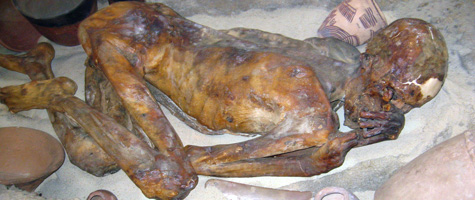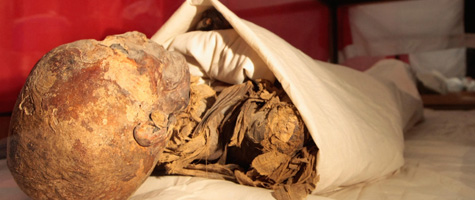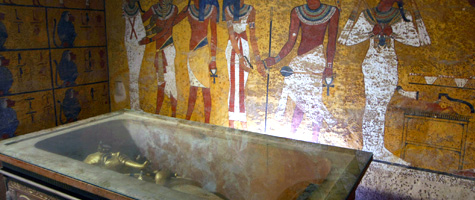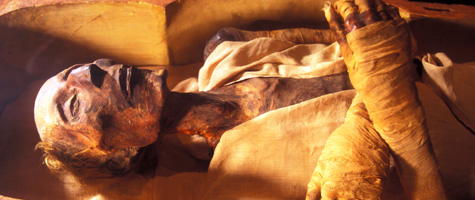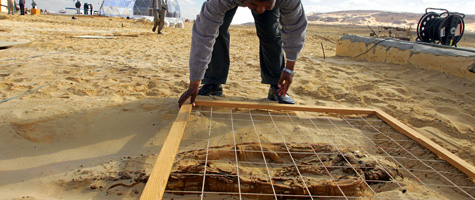The
Tsavo Man-Eaters were a pair of notorious man-eating lions responsible for
the deaths of a number of construction workers on the Kenya-Uganda Railway from March through
December 1898.
 |
| Lt. Col. John Patterson beside one of the man-eating lions he shot in 1898 |
History


 In March 1898 the British
started building a railway bridge over the Tsavo River
in Kenya. The
project was led by Lt. Col. John Henry Patterson. During the next
nine months of construction, two maneless male Tsavo lions
stalked the campsite, dragging Indian workers from their tents at night and
devouring them. Crews tried to scare off the lions and built campfires and bomas of thorn fences around their camp for
protection to keep the man-eaters out, to no avail. The lions crawled through
the thorn fences. After the new attacks, hundreds of workers fled from Tsavo,
halting construction on the bridge. Patterson set traps and tried several times
to ambush the lions at night from a tree. After repeated unsuccessful endeavours,
he shot the first lion on December 9, 1898. Three weeks later, the second lion
was found and killed. The first lion killed measured nine feet, eight inches (3
m) from nose to tip of tail. It took eight men to carry the carcass back to
camp. The construction crew returned and completed the bridge in February 1899.
The exact number of people killed by the lions is unclear. Patterson gave
several figures, claiming that there were 135 victims.[1][2]
In March 1898 the British
started building a railway bridge over the Tsavo River
in Kenya. The
project was led by Lt. Col. John Henry Patterson. During the next
nine months of construction, two maneless male Tsavo lions
stalked the campsite, dragging Indian workers from their tents at night and
devouring them. Crews tried to scare off the lions and built campfires and bomas of thorn fences around their camp for
protection to keep the man-eaters out, to no avail. The lions crawled through
the thorn fences. After the new attacks, hundreds of workers fled from Tsavo,
halting construction on the bridge. Patterson set traps and tried several times
to ambush the lions at night from a tree. After repeated unsuccessful endeavours,
he shot the first lion on December 9, 1898. Three weeks later, the second lion
was found and killed. The first lion killed measured nine feet, eight inches (3
m) from nose to tip of tail. It took eight men to carry the carcass back to
camp. The construction crew returned and completed the bridge in February 1899.
The exact number of people killed by the lions is unclear. Patterson gave
several figures, claiming that there were 135 victims.[1][2] |
| Second Tsavo Lion |
 |
| Lt. Col. John Henry Patterson |
Patterson writes in his account that he
wounded the first lion with one bullet from a Martini-Enfield
chambered in .303 caliber. This shot struck the lion in the hindquarters, but
it escaped. Later, it returned at night and began stalking Patterson as he
tried to hunt it. He shot it with a .303 Lee Enfield
several times, tracked it the next morning, and found it dead. The second lion
was shot five times with a .303 Lee Enfield, but it got up and charged him in
severely crippled condition, whereupon he shot it three more times with the Martini-Henry
carbine, twice in the chest, and once in the head, which killed it. He claimed
it died gnawing on a fallen tree branch, still trying to reach him.[3]
 |
| Lt. Col. John Henry Patterson sold the bodies of the Tsavo lions to the Field Museum in Chicago for $5,000 where they were stuffed and put on display |
After 25 years as Patterson's floor rugs,
the lions' skins were sold to the Chicago Field Museum in 1924 for a sum of
US$5,000. The lions' skins arrived at the museum in very poor condition. The
lions were then reconstructed and are now on permanent display along with the
original skulls.
Patterson's accounts were published in his
1907 book The Man-Eaters of Tsavo.
 |
| Skulls from a Taita shrine as photographed by Louis Leakey in 1929 |
Modern research
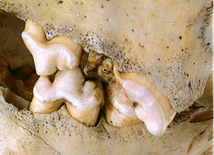 |
| Skull of FMNH 23969. Teeth deformities are visible |
The two lion specimens in Chicago's Field
Museum are known as FMNH 23970 (killed on December 9, 1898) and FMNH 23969
(killed on December 29, 1898). Recent studies have been made upon the isotopic signature analysis of Δ13C and Nitrogen-15
in their bone collagen
and hair keratin
and published in the Proceedings of the National Academy of Sciences USA.
Using realistic assumptions on the consumable tissue per victim, lion energetic
needs, and their assimilation efficiencies, researchers compared the
man-eaters' Δ13C signatures to various reference standards: Tsavo lions with
normal (wildlife) diets, grazers and browsers from Tsavo East and Tsavo West,
and the skeletal remains of Taita people from the early 20th century. This
analysis estimated that FMNH 23969 ate the equivalent of 10.5 humans and that
FMNH 23970 ate 24.2 humans [4]
This leads to the conclusion that the lower number of 35 victims is more likely
and that Patterson exaggerated his claims.[5].
It also adds credence to the infirmity theory that the root-tip abscess on the
lower right canine of FMNH 23970 (the "first man-eater) triggered the
man-eating episode.
However, an earlier (2001) study by Tom
Gnoske and Julian Kerbis Peterhans, published in the Journal of the East
African Natural History Society, contended that a human toll of 100 or more
was possible.[6]
The diet of the victims would also affect their isotopic signature. A low meat
diet would produce a signature more typical of herbivores in the victims,
affecting the outcome of the test.[7]
This research also excludes the claims that the lions were not eating the
victims they killed but merely killing just to be killing. Similar claims have
been made of other wildlife predators.
Possible causes of "man-eating" behaviour
 Theories for the "man-eating behaviour"
of lions have been reviewed by Kerbis Peterhans and Gnoske (2001) and Patterson
(2004). Their discussions include the following:
Theories for the "man-eating behaviour"
of lions have been reviewed by Kerbis Peterhans and Gnoske (2001) and Patterson
(2004). Their discussions include the following:- An outbreak of rinderpest disease (cattle plague) in 1898 devastated the lions' usual prey, forcing them to find alternative food sources.
- The Tsavo lions may have been accustomed to finding dead humans at the Tsavo River crossing. Slave caravans bound for Zanzibar routinely crossed the river there.
- "Ritual invitation", or abbreviated cremation of Hindu railroad workers, invited scavenging by the lions.
An alternative argument indicates that the
first lion had a severely damaged tooth that would have compromised its ability
to kill natural prey. Evidence for this is presented in a series of
peer-reviewed papers by Neiburger and Patterson (2000, 2001, 2002) and in Bruce
Patterson's (2004) book.
 Popular culture
Popular culture
Patterson's book was the basis for the
movies Bwana
Devil in 1952 and The Ghost and the Darkness in 1996,
with the incidents also used in 1959's Killers of Kilimanjaro. The names "The
Ghost" and "The Darkness" were names given to the two
man-eating lions. The lions also appear as a difficulty to be overcome in the
"Cape to Cairo" scenario of Railroad Tycoon II.
References
1. ^ Patterson, Bruce D. (2004). The Lions of Tsavo: Exploring the
Legacy of Africa's Notorious Man-Eaters. McGraw-Hill. ISBN 0071363335.
2. ^ Gnoske, Thomas and Julian Kerbis Peterhans (2003). "Field
Museum uncovers evidence behind man-eating; revises legend of its infamous
man-eating lions". Journal of East African Natural History.
3. ^ chapter IX The Death of the Second Lion, The Man-Eaters
of Tsavo and other East African Adventures by Lieut.-Col. J. H. Patterson,
DSO publication date unknown as recorded on Amazon Kindle
4. ^ Yeakel JD, Patterson BD, Fox-Dobbs K, Okumura MM, Cerling
TE, Moore JW, Koch PL, Dominy NJ. (2009). Cooperation and individuality among
man-eating lions. Proc Natl Acad Sci USA. 106: 19040–19043. doi:10.1073/pnas.0905309106 PMID 19884504
5. ^ Janssen, Kim (November 2, 2009). "Scientists
restate Tsavo lions' taste for human flesh". Chicago Tribune.
7.
^ Krueger, H.W.; Sullivan, C.H. (July 9th). "Models for
Carbon Isotope Fractionation Between Diet and Bone". ACS Symposium
Series. ACS Symposium Series 258: 205–220. doi:10.1021/bk-1984-0258.ch014.
ISBN 0-8412-0855-7. Retrieved 5 December 2011.
Further reading
- Neiburger, E.J. & B.D. Patterson. 2000. Man eating lions…a dental link. Journal of the American Association of Forensic Dentists 24(7-9):1-3.)
- Neiburger, E.J. & B.D. Patterson. 2000. The man-eaters with bad teeth. New York State Dental Journal 66(10):26-29+cover.
- Kerbis Peterhans, J.C. and T.P. Gnoske (2001). The science of 'Man-eating' among lions (Panthera leo) with a reconstruction of the natural history of the "Man-eaters of Tsavo, Journal of East African Natural History 90:1-40.
- Patterson, B.D., E.J. Neiburger & S.M. Kasiki. 2003. Tooth breakage and dental disease as causes of carnivore-human conflicts. Journal of Mammalogy 84(1):190-196.
- Patterson, B.D. 2004. The lions of Tsavo: exploring the legacy of Africa’s notorious man-eaters. McGraw-Hill, New York, 231 pp.
- Patterson, B.D., S.M. Kasiki, E. Selempo & R.W. Kays. 2004. Livestock predation by lions (Panthera leo) and other carnivores on ranches neighboring Tsavo National Parks, Kenya. Biological Conservation 119 (4):507-516
- Patterson, B.D. 2005. Living with lions in Tsavo, or notes on managing man-eaters. Travel News & Lifestyle (East Africa) 129 (Feb 2005):28-31.
- Dubach, J, B.D. Patterson, M.B. Briggs, K. Venzke, J. Flammand, P. Stander, L. Scheepers & R. Kays. 2005. Molecular genetic variation across the eastern and southern geographic range of the African lion, Panthera leo. Conservation Genetics 7:15-24.
- Patterson, B.D., R.W. Kays, S.M. Kasiki & V.M. Sebestyen. 2006. Developmental effects of climate on the mane of the lion (Panthera leo). Journal of Mammalogy 87(2):193-200.
- Gnoske, T.P., G. Celesia, and J.C. Kerbis Peterhans, (2006). Dissociation between mane development and sexual maturity in lions (Panthera leo): Solution to the Tsavo Riddle? J of Zoology (London) 270(4): 1-10.
- Kerbis Peterhans, J.C., C.M. Kusimba, T.P. Gnoske, S. Andanje & B.D. Patterson (1998). Man-eaters of Tsavo rediscovered after 100 years, an infamous ‘lions den’, rekindles some old questions. Natural History 107(9):12-14.
- Patterson, B.D. 2004. The lions of Tsavo: exploring the legacy of Africa’s notorious man-eaters. McGraw-Hill, New York, 231 pp.
Taken
from http://en.wikipedia.org/wiki/Tsavo_maneaters
Go and visit Tsavo National Park or combine it with a nice Indian Ocean beach Holiday! Click here



















 http://www.africanencounters.com/specials/egypt
http://www.africanencounters.com/specials/egypt